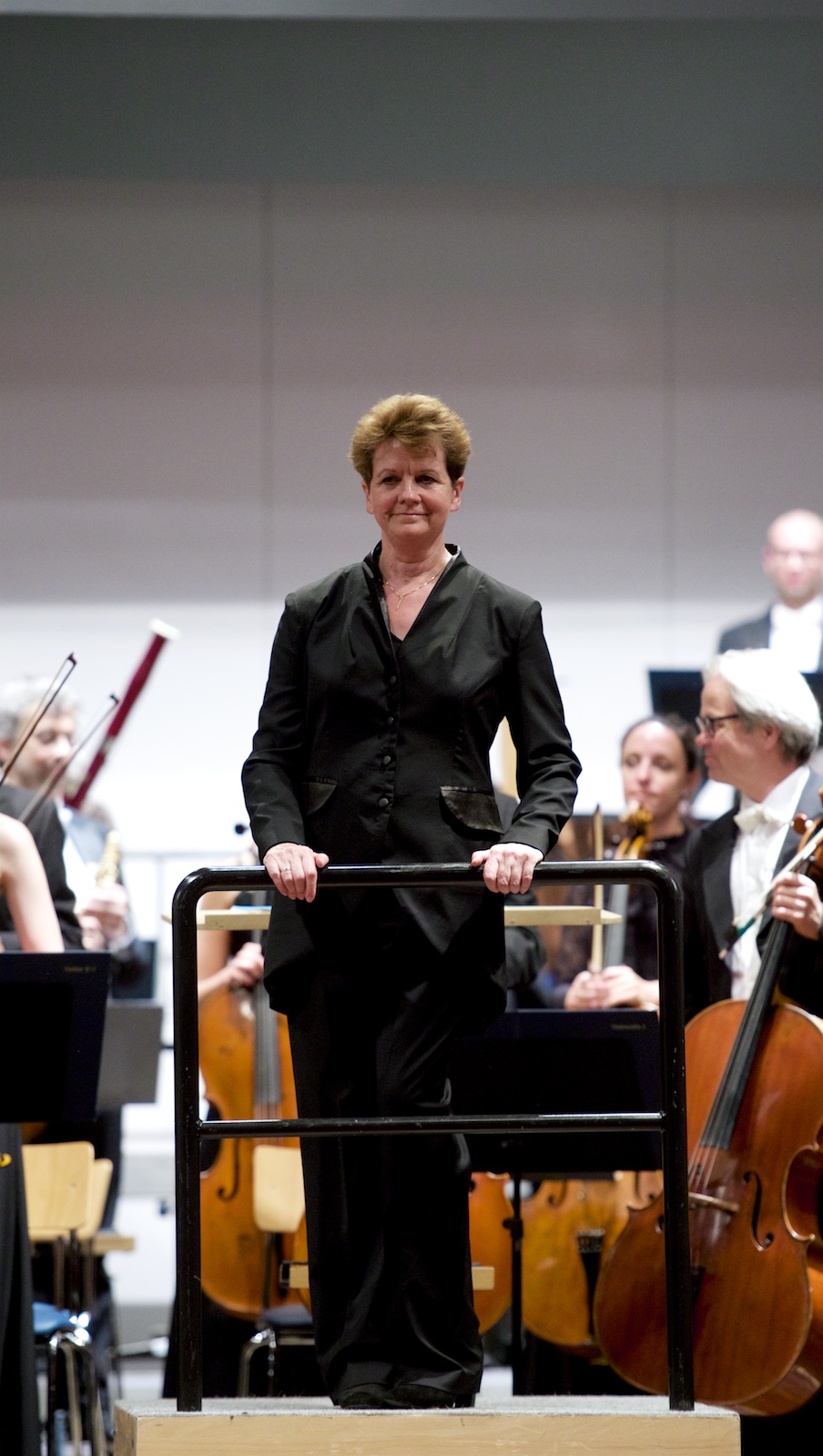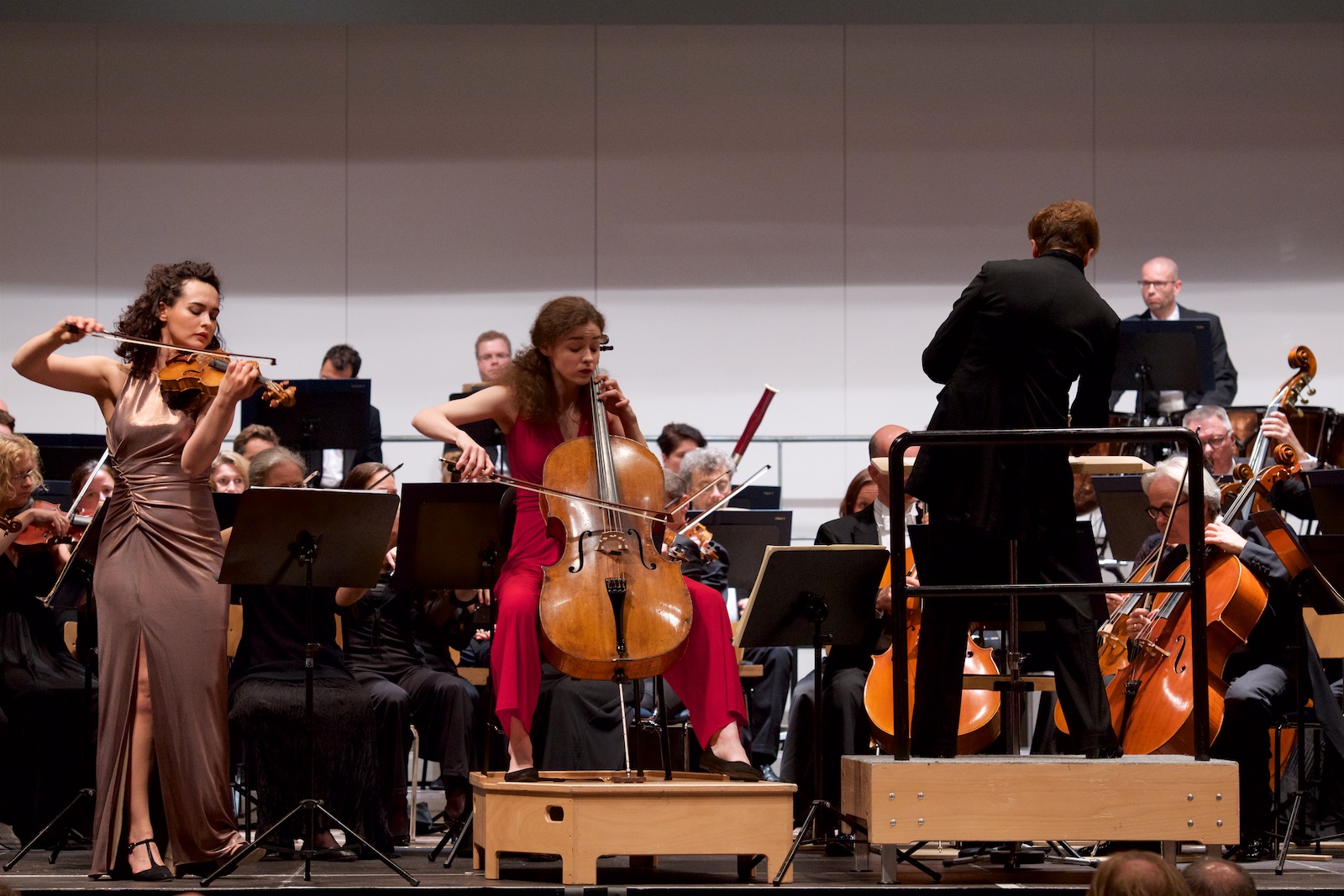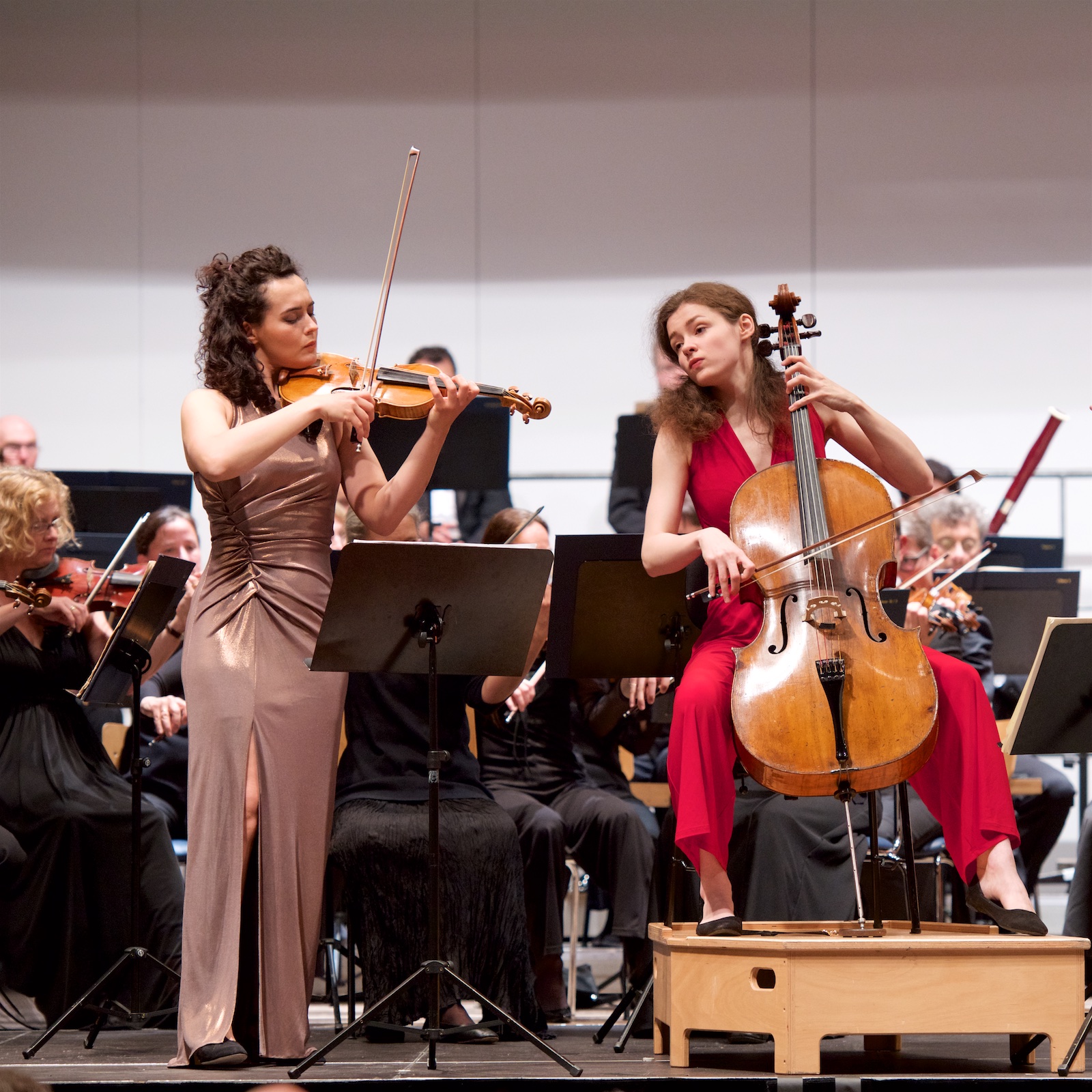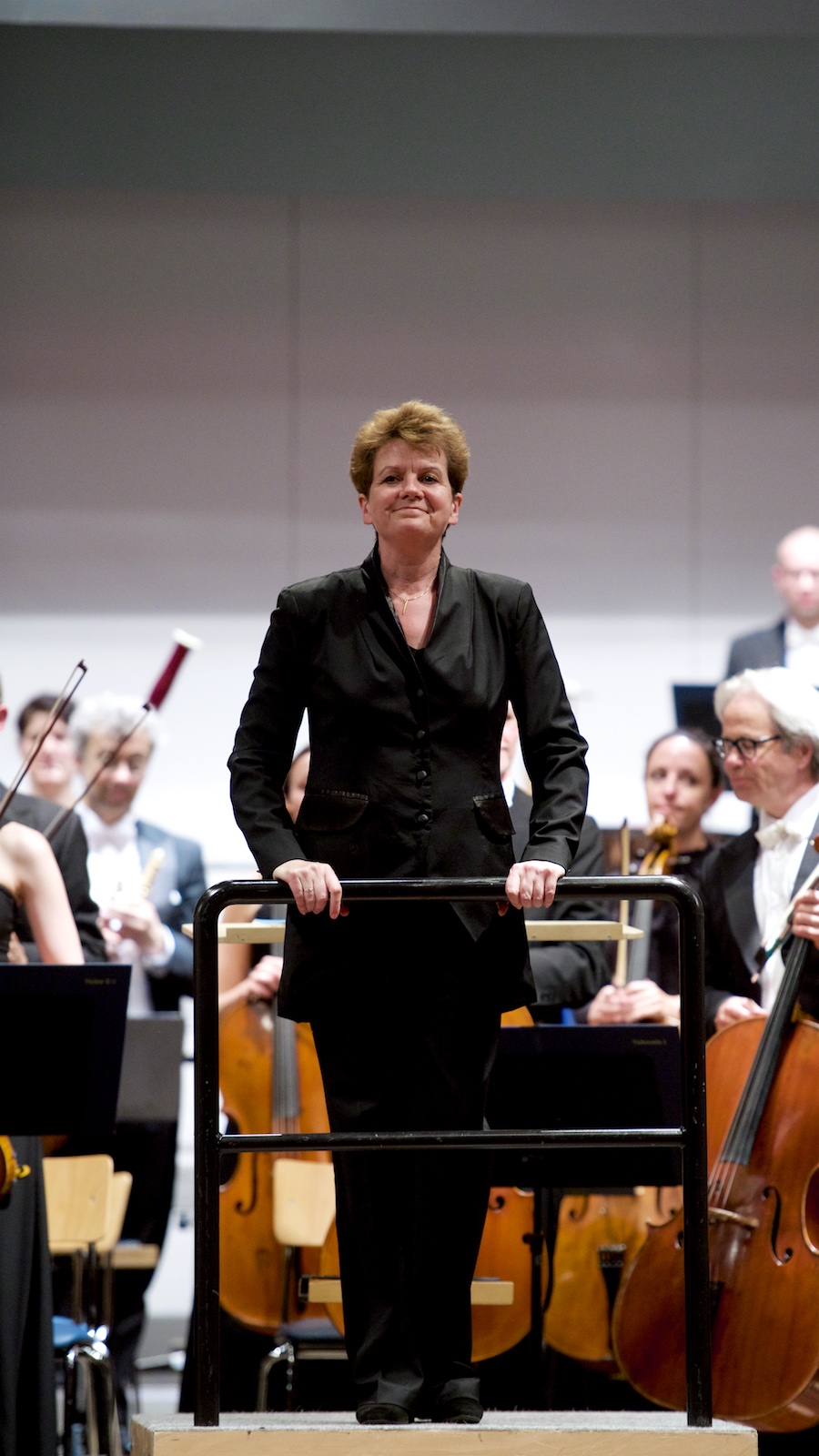Anastasia Kobekina, Alena Baeva, Julia Jones / Wuppertal SO
Haydn / Brahms / Mendelssohn
Stadthofsaal, Uster, 2018-05-17

2018-05-23 — Original posting
Table of Contents
Introduction
The Venue
I live in the small town of Uster (population around 35,000), and relatively close to Zurich. The latter sucks up most cultural activities & attention. This makes cultural life in Uster even more provincial that it usually is in small locations anyway.
We have churches that may be used for concerts, some smaller venues—and the Stadthofsaal, an event hall with a small stage that is used for all sorts of community events & celebrations. Its acoustics are not ideal for concerts, to say the least—but that’s all we have in terms of “concert hall”. The seating plan for this event showed seats for an audience of 242; the hall could easily hold 300 people.
Expectedly, the number of concerts in Uster is rather small: typically, I take the train to Zurich or farther away to attend concerts. The announcement for this concert sounded like a once-in-a-year opportunity (for Uster) that I could hardly deny. So, my wife and I booked seats in the last row (row 9). These were seats with excellent sight, and acoustically at least as good as any other. Plus, from the center of the last row, I could take photos without disturbing people behind me!
The Orchestra
The concert in Uster was organized by Top Klassik Zürcher Oberland, one of the main concert organizers in the Canton of Zurich, outside of the city of Zurich itself. The announcement for the concert focused on the Wuppertal Symphony Orchestra (Sinfonieorchester Wuppertal, see also Wikipedia). The orchestra has been the career starting point for several notable conductors, such as Erich Kleiber (1890 – 1956), Otto Klemperer (1885 – 1973), Hermann Ritter von Schmeidel (1894 – 1953), and Hans Edgar Weisbach (1885 – 1961).
Wuppertal is a mid-size town south of the Ruhrgebiet, east of Düsseldorf. The orchestra goes back to 1862. It serves both opera, as well as concerts, and its activities center around Wuppertal itself, with occasional tours in Europe. The concert in Uster was the end-point of a short tour that started with two concerts in Wuppertal (2018-05-13 and 2018-05-14), took the orchestra to the Sala Verdi del Conservatorio in Milan (2018-05-16), and ended in Uster on the following day, on the way back home.
Conductor
Since the season 2017/2018, the Wuppertal Symphony Orchestra is under the direction of Julia Jones. Julia Jones was born 1961 on the Isle of Man. She received a broad musical education at Chetham’s School of Music, later at the University of Bristol, and finally at the Guildhall School of Music and Drama. Her career as conductor took her to Cologne , then to Stuttgart, to Ulm (1991 – 1995), on to Darmstadt (1995 – 1997), to Basel (1998 – 2002). In 2008 – 2011, she was principal conductor of the Orquestra Sinfónica Portuguesa at the Teatro Nacional de São Carlos. After engagements as guest conductor, she finally was named General Music Director in Wuppertal, which includes the directorship at the theater in the same city.
The Soloists
For the central concerto on this tour, the orchestra hired two soloists:
Anastasia Kobekina
The young Russian cellist Anastasia Kobekina was born 1994 in Ekaterinburg into a family of musicians. In her home town, she received her initial musical education, which she continued and completed in the Central Music School in Moscow. Further studies took her to the Kronberg Academy in Germany, where she worked with Frans Helmerson (*1945). She is currently studying with Jens Peter Maintz (*1967) at the University of Arts in Berlin. Anastasia is at the start of her international career. Yet, she has already performed orchestral and chamber music with very notable artists, and at international festivals.
Alena Baeva
The violinist Alena Baeva (*1985, see also Wikipedia) grew up in Almaty, Kazakhstan. Alena Baeva started her initial education at age 5, in her home town. From 1995, she studied at the Central Music School in Moscow, completing her education in 2007 at the Moscow Conservatory. She was a protégée of Mstislav Rostropovich (1927 – 2007), as well as Seiji Ozawa (1935 – 2024).
In 2000, Alena Baeva won the first prize at the T. Wronski solo violin competition in Warsaw, in 2001 she won the First Prize and nine Special Prizes at the XII International Henryk Wieniawski Violin Competition. In 2004, she was the Grand Prize winner at the Second Moscow Paganini Violin Competition. Finally, in 2007, she won the Gold Medal and the Audience Prize at the Sendai International Violin Competition in Japan.
With these awards, her career has of course progressed much further than that of Anastasia Kobekina. Alena Baeva is now commanding a substantial concert repertoire. She has started recording, she performs with very notable orchestras and conductors, in Russia, as well as throughout Europe, in Japan and in Israel. For further details see her Biography.
Further Context
Sadly (but not atypical for a provincial setting), the hall was only about 2/3 full. Of course, the orchestra’s travel schedule did not offer much flexibility in choosing the date, and on that day, there were several events in parallel. At least, one could assume that those who did attend were really interested in the performance.
The orchestra presented itself in “romantic” configuration, violin 1 and violin 2 at the left (around 10 each), 3 cellos, 6 violas at the right, 3 double basses in the rear right. The podium had been enlarged into the hall for this concert, with most string instruments sitting outside of the actual stage / podium area. This proved to be somewhat non-ideal, see below.
Of course, this is not the Berlin Philharmonics, but a mid-range German orchestra. And an orchestra on tour, with the associated limitations and restrictions, such as tiring travel, limited rehearsal time, limited facilities for artists, at least in Uster. In addition, I heard “through the grapevine” that the orchestra’s car had been blocked on the road from Italy to Uster, causing extra strain, and leaving very little, if any rehearsal time in Uster. With this, I will try not to be too critical about the performance in this concert, but focus on describing my listening experience.
Photos
All concert photos are by the author (© Rolf Kyburz, all rights reserved).
Haydn: Overture to “L’infedeltà delusa“
“L’infedeltà delusa” (Deceit Outwitted), Hob.XXVIII/5, is an Operatic Burletta. Franz Joseph Haydn (1732 – 1809) wrote this (one of 24 operas in his oeuvre) in 1773. Julia Jones conducted the overture of this opera. Actually it is a sinfonia in three short movements:
- Allegro
- Poco adagio
- Presto
The three-part sinfonia-overture is a concept that Haydn inherited from baroque composers.
The Performance
The overture is an opportunity for the orchestra to get acquainted with the acoustics (with the presence of the audience, this may be different from rehearsals!). At the same time it allows the audience to adjust their ears to the venue, and to the sound of the orchestra.
I. Allegro
For the most part, this is not a “traveling orchestra” (i.e., touring around is only a small part of its activities). Yet, the orchestra managed very well and instantly adapted to the venue. I found the general sonority, the discipline, the coordination to be good. Maybe the ensemble was somewhat on the big side, considering today’s trend towards historically informed performances. On the other hand, the bigger number of instrumentalists makes the sound more homogeneous. The articulation was light, maybe at times a bit on the robust side (which may also be because of the size of the orchestra).
I instantly noted that the sound was dominated by the string instruments. This, and their occasionally slightly coarse, robust sound was clearly a consequence of the acoustics, which made the strings sound louder and more direct than the wind instruments in the rear.
II. Poco adagio
The articulation was careful. I noted some limitations: there were some real pp, but for the most part, I felt that p typically sounded like mf. In general, the dynamic scale seemed restricted at the lower end, especially with the violins. The orchestra could easily have risked a softer p. However, once more: this was a venue the orchestra was not familiar with, and which it had very little time to adapt to. And in the case of doubt about how it would sound with in this location (from a listener’s perspective), it is certainly safer, even wise not to take too much risk.
III. Presto
A very short movement (as already the Poco adagio). Clear, with light staccato playing. Carefully crafted dynamics, though more in the sense of staged dynamics, with somewhat limited Klangrede. However, one should not exaggerate the elaboration of details in such a short piece.
One general impression was that either the orchestra was too big for the venue, or the venue too small for the orchestra. However, one certainly can’t blame this on the orchestra.
Rating: ★★★
Brahms: Double Concerto for Violin and Cello in A minor, op.102
The last orchestral work that Johannes Brahms (1833 – 1897) wrote is his Double Concerto for Violin, Cello and Orchestra in A minor, op.102. Brahms composed this in the summer of 1887, during a stay at the Lake of Thun, in Switzerland.
It was the cellist Robert Hausmann (1852 – 1909) who asked Brahms for a concert piece for his instrument. As a pianist, Johannes Brahms was rather hesitant about writing for instruments that he was not really familiar with. Ultimately, however, his consultations for this composition led to a reconciliation with his long-time friend, the violinist Joseph Joachim (1831 – 1907). Joachim and Hausmann were also the soloists who premiered the concerto, first privately (Baden-Baden, 1887-09-23), then for a public audience in Cologne (1887-10-18).
The concerto features three movements:
- Allegro
- Andante
- Vivace non troppo
Besides the two solo parts, the score asks for an orchestra with 2 flutes, 2 oboes, 2 clarinets, 2 bassoons, 4 horns, 2 trumpets, timpani, and strings.
The Performance
For the Brahms double concerto, I’ll focus on the soloists almost exclusively. My essential remarks concerning the orchestra I made above already. My main point here is that the orchestra was rather loud, massive, which for the most part I attribute to the acoustics, not the orchestra or the direction. I don’t think there was any time for the orchestra at all to try adjusting to the venue / the acoustics.
The soloists had sheet music in front of them, even though both obviously knew their part well enough and mostly by heart. The music stand probably was more of a safety net than an actual necessity (though the page turning was a bit disruptive, occasionally).
I. Allegro
The tempo in this movement was certainly not too slow!
After the initial fanfare in the orchestra, Anastasia Kobekina “enters the stage” with an extended, recitative-like solo (In modo di recitativo, ma sempre in tempo). I found her playing very expressive throughout the movement, even the entire concerto. It was maybe somewhat exaggerated in the first few bars, but the cellist corrected that rather quickly. With the dry acoustics of the venue, the solo cello was very present! The cello sounded impulsive, expansive, self-conscious, and emotional. Maybe too emotional, occasionally? Well, she is very young, still, so some “overshooting” is understandable, even natural, I think.
Alena Baeva’s violin playing clearly showed more maturity, more moderation. She did not try to dominate. Her articulation, the playing in general seemed lighter than that of the cellist (apart from the characteristics of the instruments, of course). She also sounded more cultivated, also more independent, showing the extra years of experience on the podium. My only (personal) quibble would be that Alena Baeva’s often intense vibrato sounded somewhat nervous, at times (but OK, I have a personal preference for violin playing with little vibrato). The cellist’s vibrato was often strong and expressive, too, but not exceedingly nervous. However, apart from the difference in temperament and experience, I found that the mutual accord between the soloists, in terms of agogics / tempo, rhythmic coordination, and in dynamics was excellent.
II. Andante
What a beautiful, joint cantilena of the two soloists—particularly in the rather intimate atmosphere in this venue. Something positive about the hall, at last! Was the tempo a tad fast, or was it the beauty of the solo cantilenas that made me want it to be slower / last longer?? Again, the solo violin seemed more differentiated, more cultivated in the sound. But that also has to do with age and experience. There are numerous transitions where motifs are passed between the two soloists. There, I found the violin to blend better into the cello than the cello into the violin.
Generally speaking, I felt that the cellist seemed to focus more on the moment, the local expression than the violinist. The latter appeared to think in bigger phrases & arches.
III. Vivace non troppo
Also here, the tempo seemed rather fluent, if not occasionally sporty. This did not cause any technical issues with either of the soloists. Their playing was technically superb throughout. However, it may have limited the amount of expression / articulation that the musicians could convey to the audience. For both soloists, it’s a very busy movement. In my view, it was the cellist’s best movement in this concerto: full of power and momentum. True, at times, the cello was a little less controlled in articulation than the violin, and the intonation occasionally was a tad “emotional”. However, that was more than compensated by the lively expression, the drive, the youth in Anastasia Kobekina’s playing, often almost overflowing with expression.
Both solo instruments projected really well, never had any issues in making themselves heard, despite the robust orchestra sound. But that’s in parts the benefit of Brahms’ diligent orchestral disposition.
Throughout the concerto, it was a joy to watch the two soloists keep an eye on each other, while at the same time staying in close contact with conductor and orchestra. Both were / are really excellent! While Alena Baeva has pretty much established herself already internationally, I’m sure that Anastasia Kobekina’s future as a soloist looks just as bright. I wish both these soloists best of luck for their respective career, and I sure hope to hear them again in the near future!
Rating: ★★★½
Mendelssohn: Symphony No.3 in A minor, op.56, “Scottish”
In 1829, Felix Mendelssohn Bartholdy (1809 – 1847) paid his first visit to Britain. He initially stayed in London for concert performances, then embarked on a walking tour in Scotland. A visit to the ruins of Holyrood Chapel at Holyrood Palace in Edinburgh was the trigger that gave the composer the inspiration to the beginning of his “Scottish” symphony.
Years passed by before Mendelssohn picked up his first sketches again. He seriously worked on the symphony in 1841, completing it in 1842, and published it in the same year, as Symphony No.3 in A minor, op.56, “Scottish”. The composition features the following movements:
- Andante con moto — Allegro un poco agitato
- Vivace non troppo (F major)
- Adagio (A major) —
- Allegro vivacissimo — Allegro maestoso assai
The instrumentation calls for 2 flutes, 2 oboes, 2 clarinets, 2 bassoons, 4 horns, 2 trumpets, timpani, and strings: an ideal fit to Brahms’ double concerto.
The Performance
For the symphony, the orchestra was slightly bigger than for the initial piece: 8 violas, 5 cellos, 4 double basses, rather than the initial 6 + 3 + 3. This improved the balance within the strings. At the same time, it reinforced the impression of too big an orchestra playing in too small a venue, a hall better suited for chamber music, maybe.
I. Andante con moto — Allegro un poco agitato
Initially, the violins remain silent, and so, the woodwinds got a real chance to present themselves. The dry acoustics actually helped giving some presence to the rear parts of the orchestra (woodwinds, brass). Also in the symphony, however, the strings remained fairly strong, if not occasionally even a bit coarse—certainly robust rather than very subtle.
The articulation was really careful in the main theme in the Allegro un poco agitato part. Julia Jones conducted precisely, had the orchestra under control at all times. She clearly knows her “business” well and is familiar with the composition. Sadly, the exposition was not repeated. However, that may have been a decision considering the strain from traveling.
In general, I liked the quality of the orchestra; the cello sound was warm and harmonious, the violins are technically very good, even though—as stated—occasionally a bit coarse (acoustics?). As earlier that evening, the dynamics often appeared a bit narrow on the soft side (p, pp), could occasionally have been a bit more subtle. The wind instruments were excellent. Rarely, a tone did not respond as expected, but didn’t affect the outcome, the overall impression.
While the articulation, the “local expression” may sometimes have been a bit “robust”, I liked how Julia Jones shaped the big dynamic arches, the waves with which Mendelssohn appears to describe storm, gusts of wind blowing through the Scottish landscape, towards the climax near the end of the movement.
II. Vivace non troppo
Things I noted: the very mellow, flexible sound of the clarinet: really excellent, and virtuosic playing, also in the oboes and flutes. The tutti was occasionally a bit too straight, strict (I even noted “military”!). The tempo was at the upper limit: just what the orchestra still could manage sufficiently well. At times, it felt as if Julia Jones let the orchestra off the leash, unstoppable. And I liked the almost ghastly scurrying away at the end!
III. Adagio —
A careful interpretation, albeit a bit “big” at times, and very loud in the ff middle part. The “hair in the soup” was in some moderate intonation issues, particularly in wind instruments (woodwind and brass). Were the musicians tired from the traveling? Should they have taken the time for an extra tuning prior to this movement? Still, I noted string cantilenas with very diligent and detailed phrasing and articulation, and the last bars were really touching and serene!
IV. Allegro vivacissimo — Allegro maestoso assai
Also here, Julia Jones went as far as the orchestra could (just) still manage, in terms of tempo. The punctuated notes in the first theme started to sound slightly superficial, occasionally inaccurate. The interpretation didn’t feel light and transparent, rather robust, occasionally loud (yes, the fault of the acoustics, I know…). The polyphonic parts sometimes lacked clarity.
The Allegro maestoso assai part, finally, seemed to offer relief for all the tension that accumulated in the first part. It was as if everybody suddenly dared to breathe again! Though, Julia Jones kept the tempo moving forward, did not allow herself and the orchestra to over-indulge in the beautiful A major ending with its beautiful, catchy, truly majestic theme. Mendelssohn’s excellent invention did not fail to have its effect on the listener!
Rating: ★★★
Closing Remarks
Rather than complaining about the lack of a good concert venue in Uster, and/or about the scarce attendance: thanks to all the artists for bringing so much beautiful music into the provincial setting! I think I’m speaking for all of the audience: you are welcome back any time!













